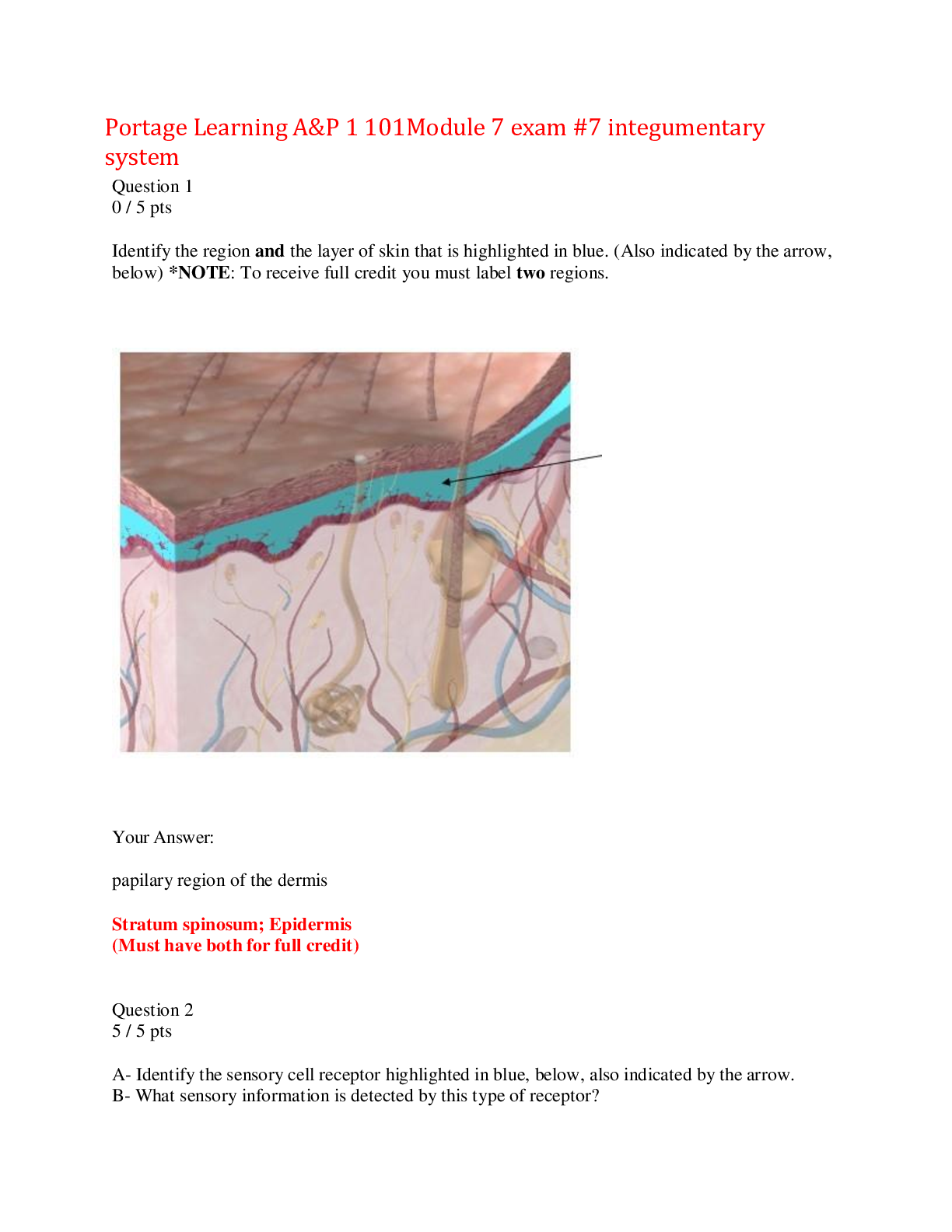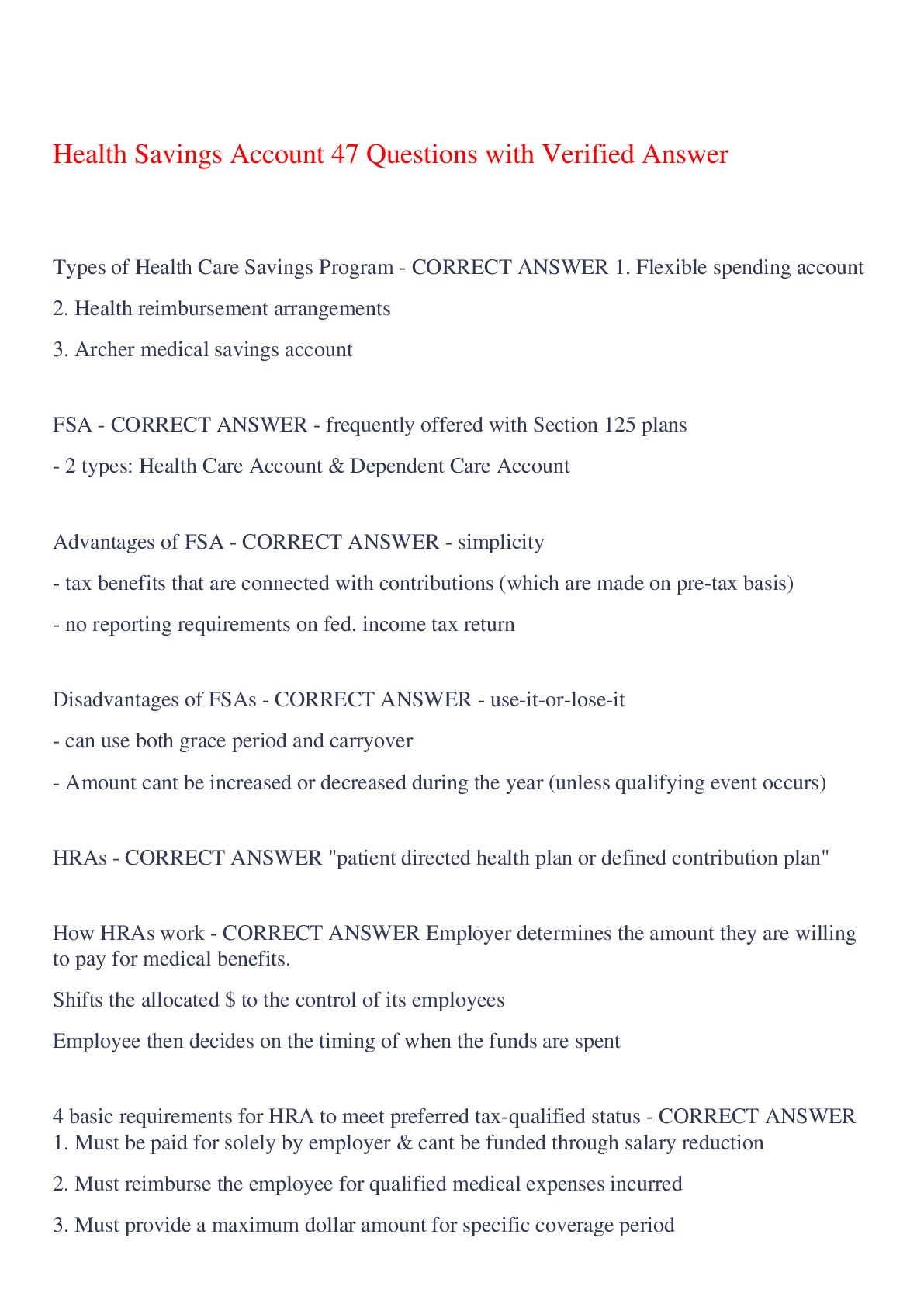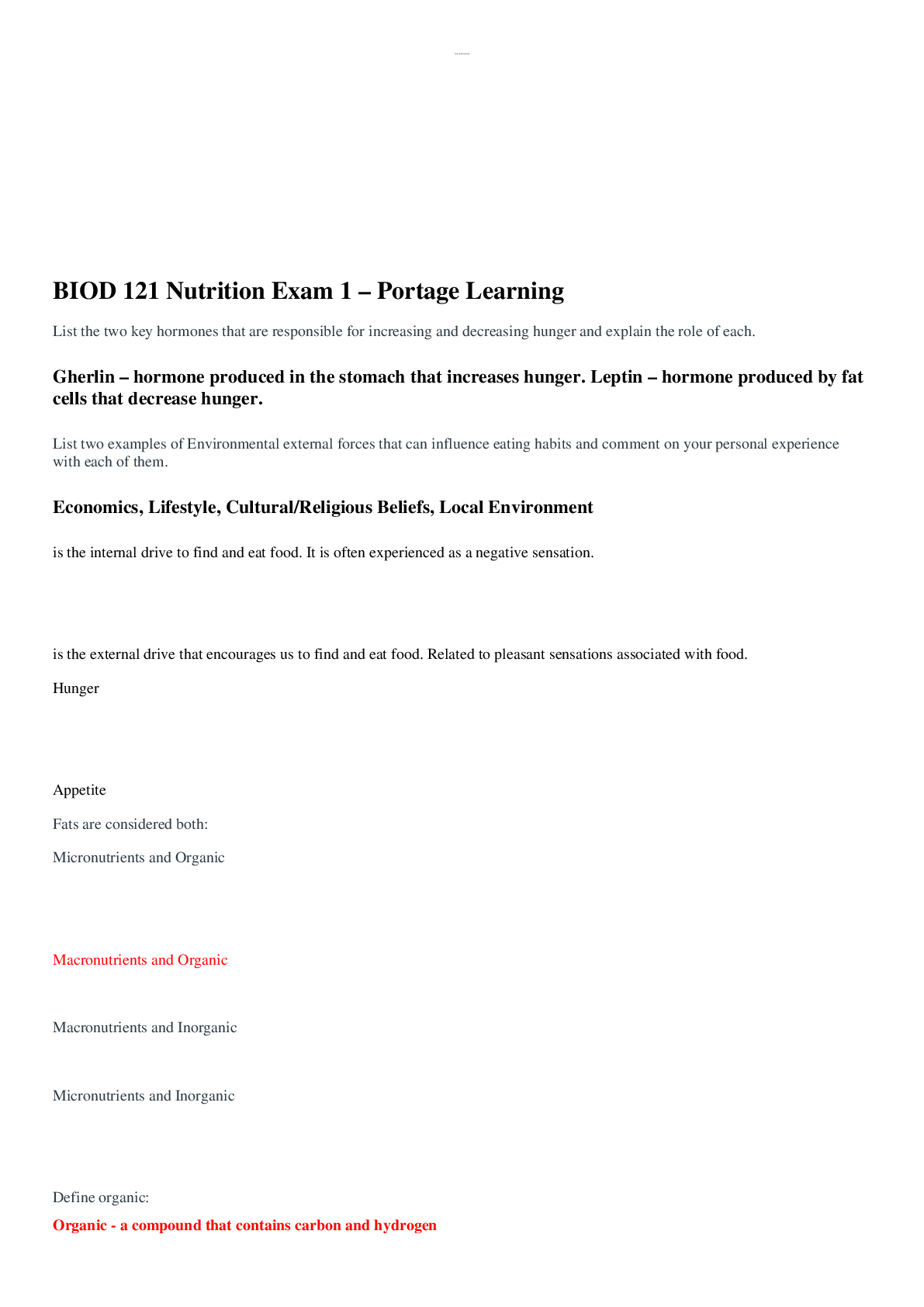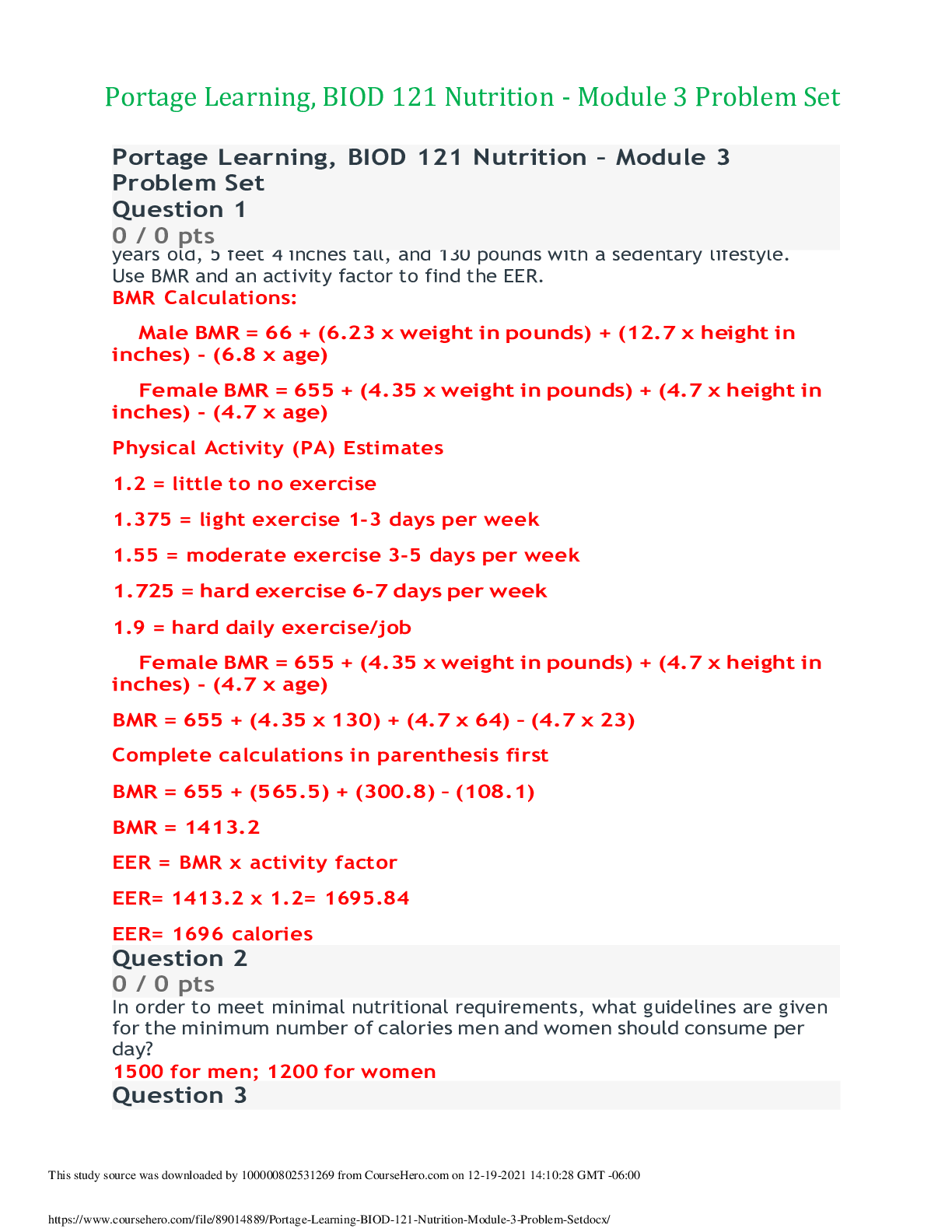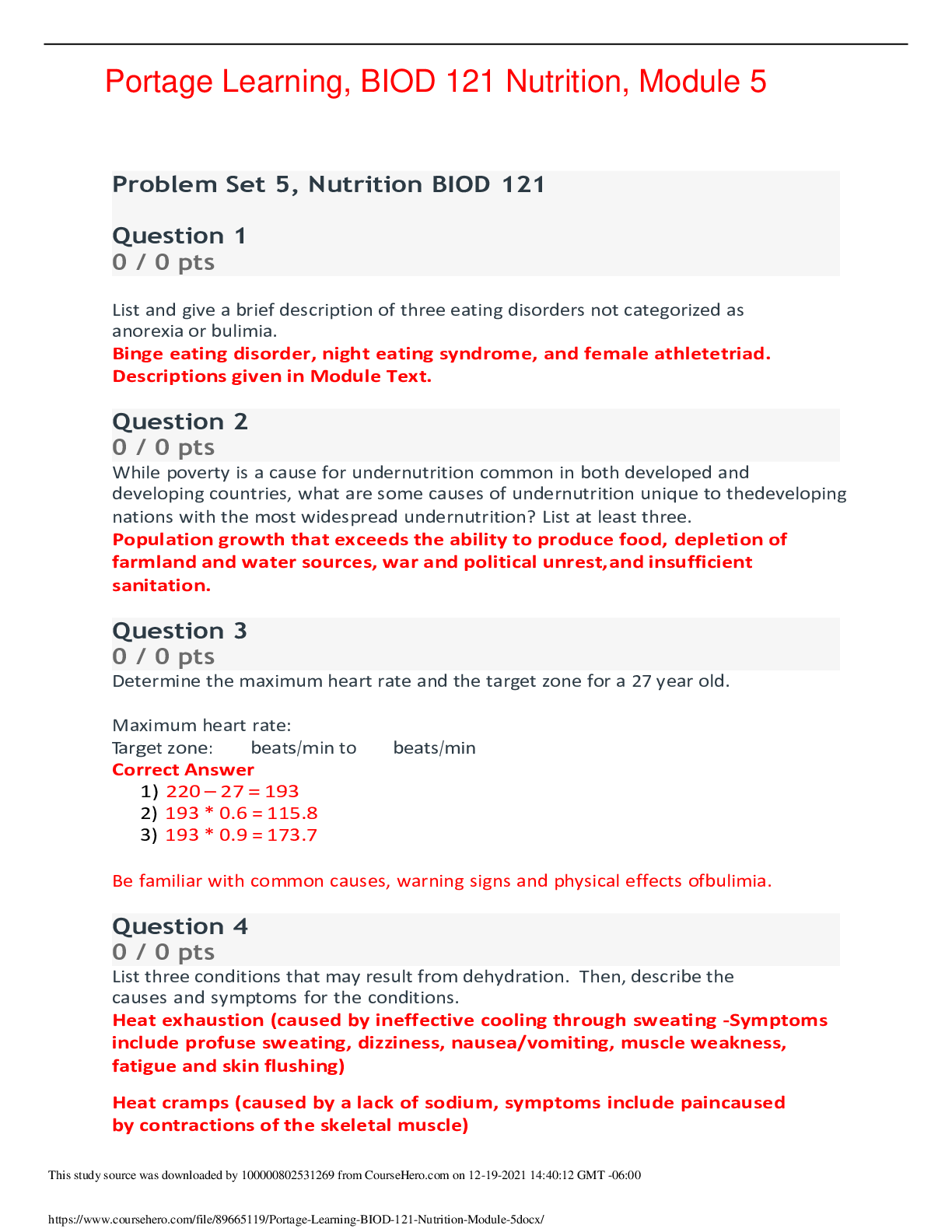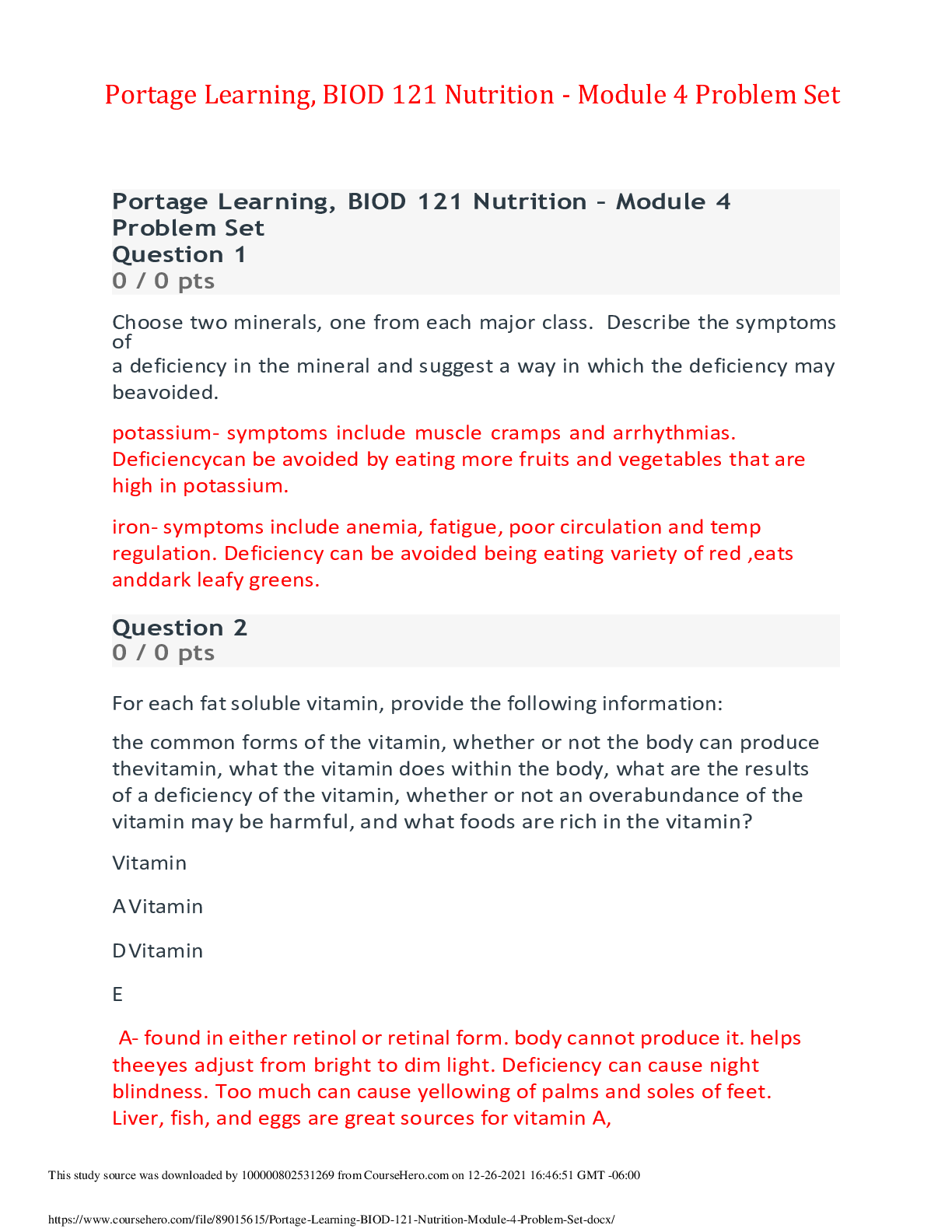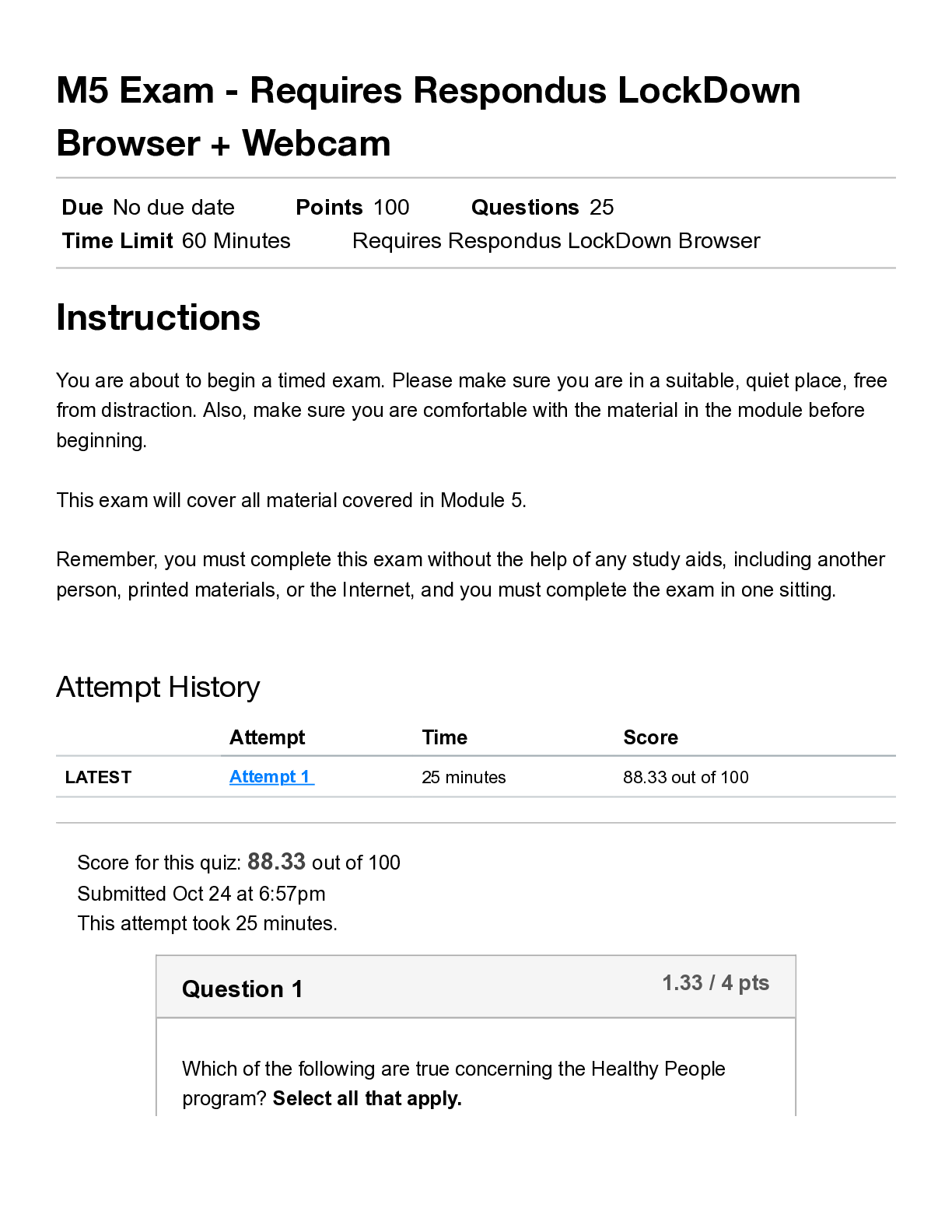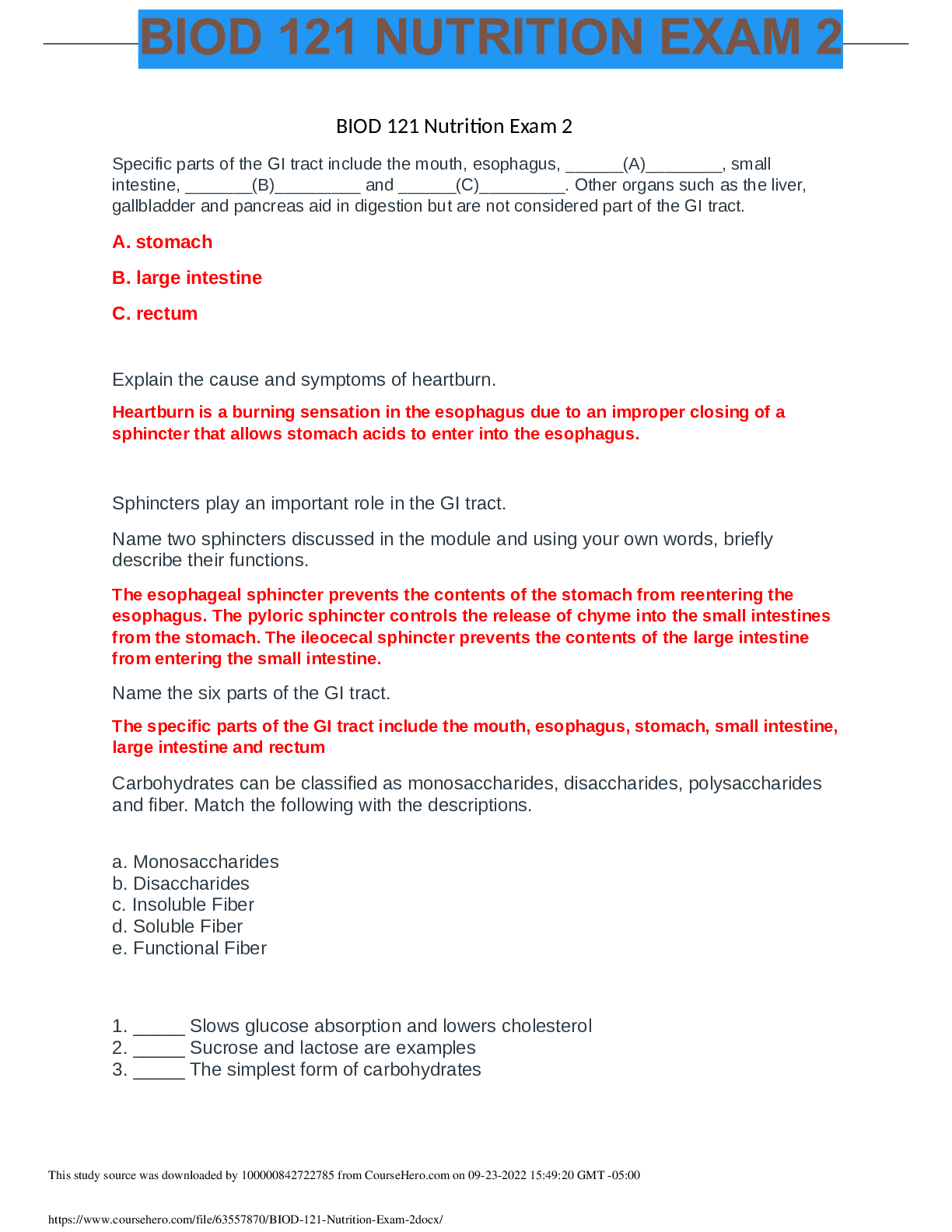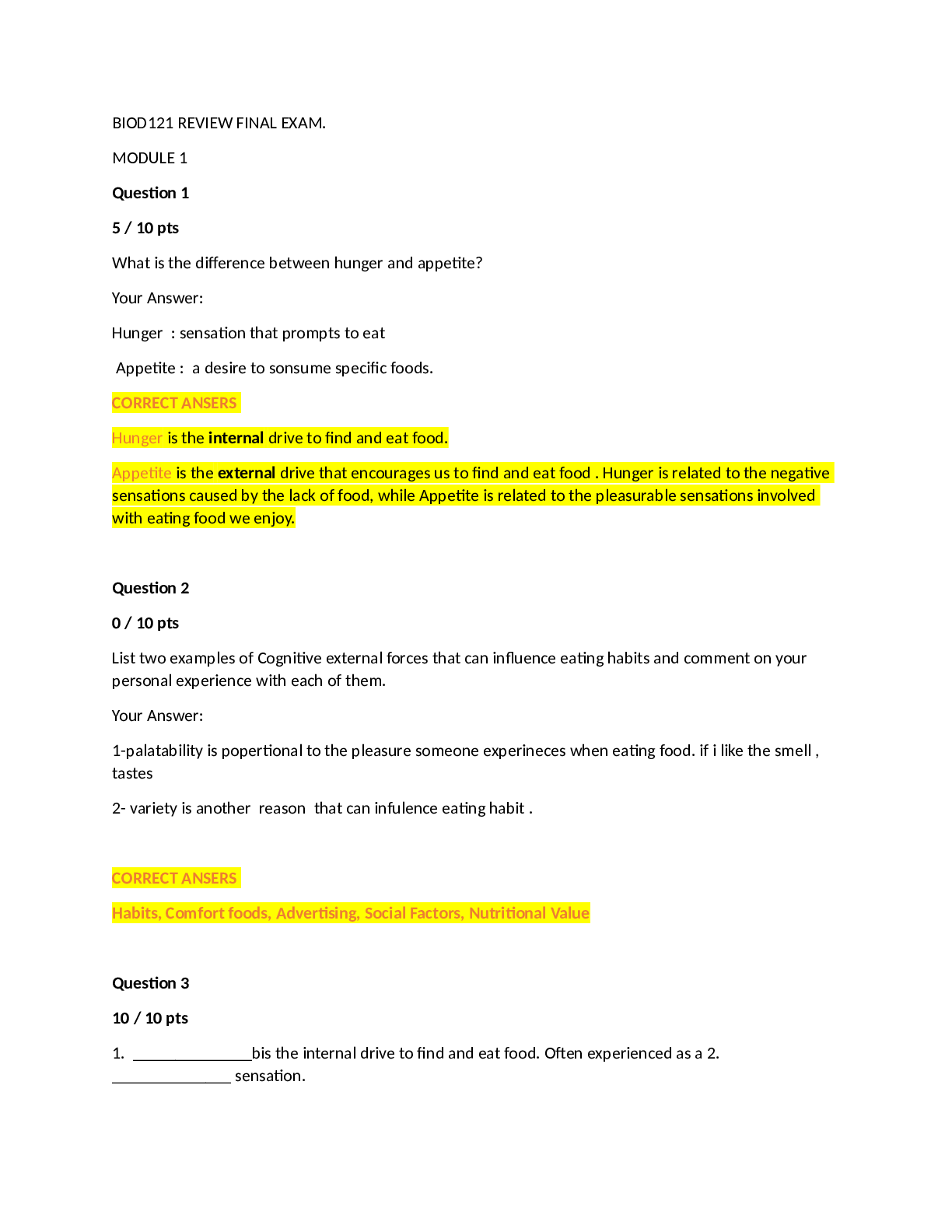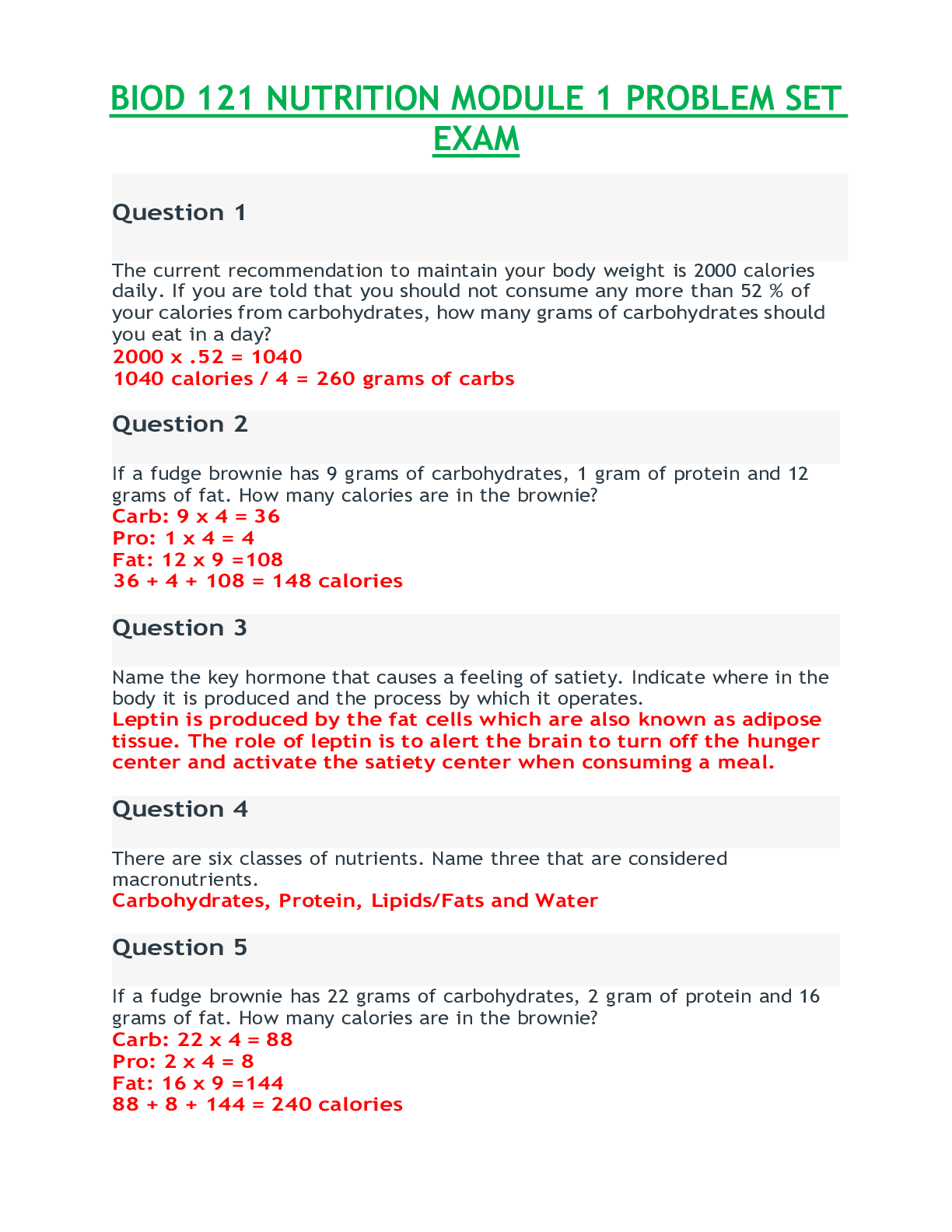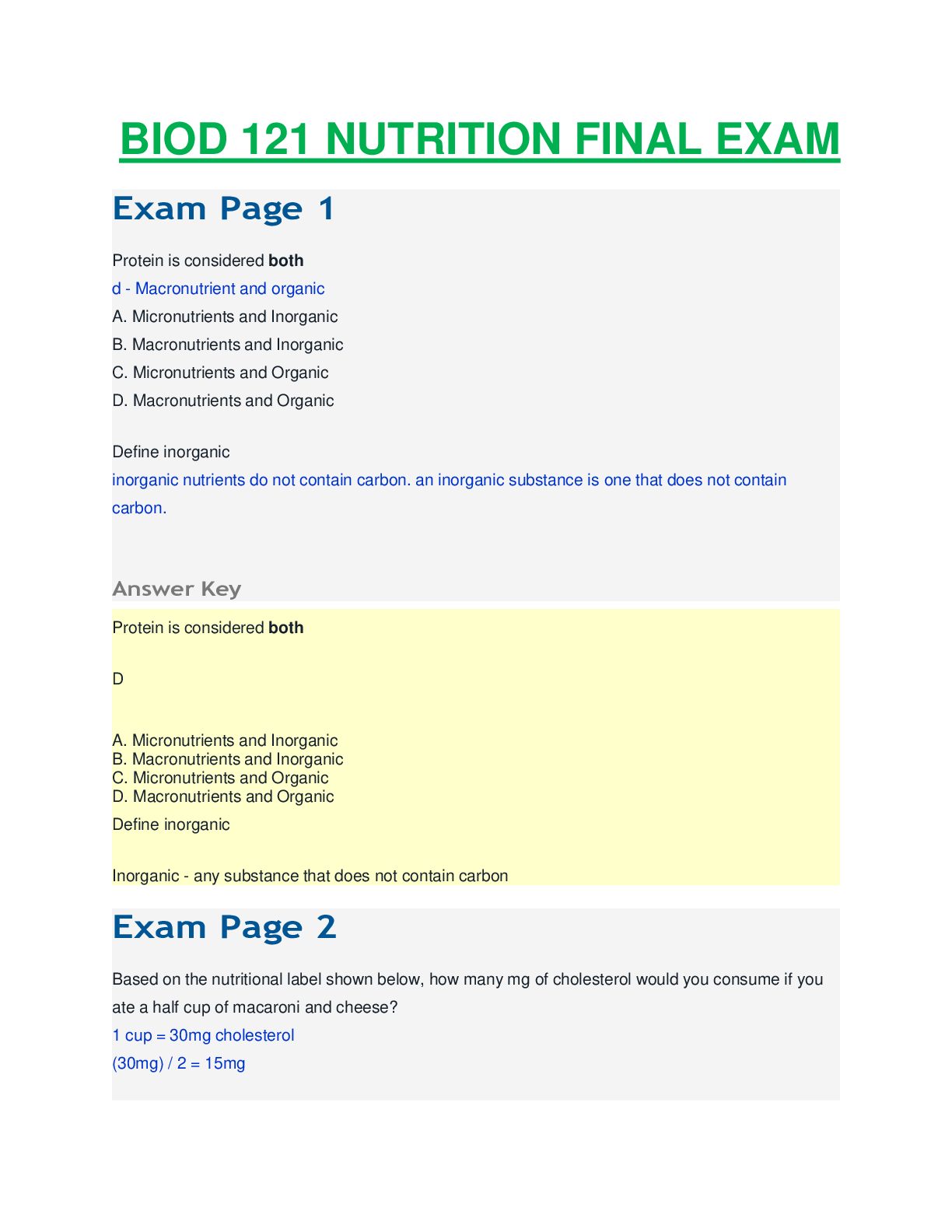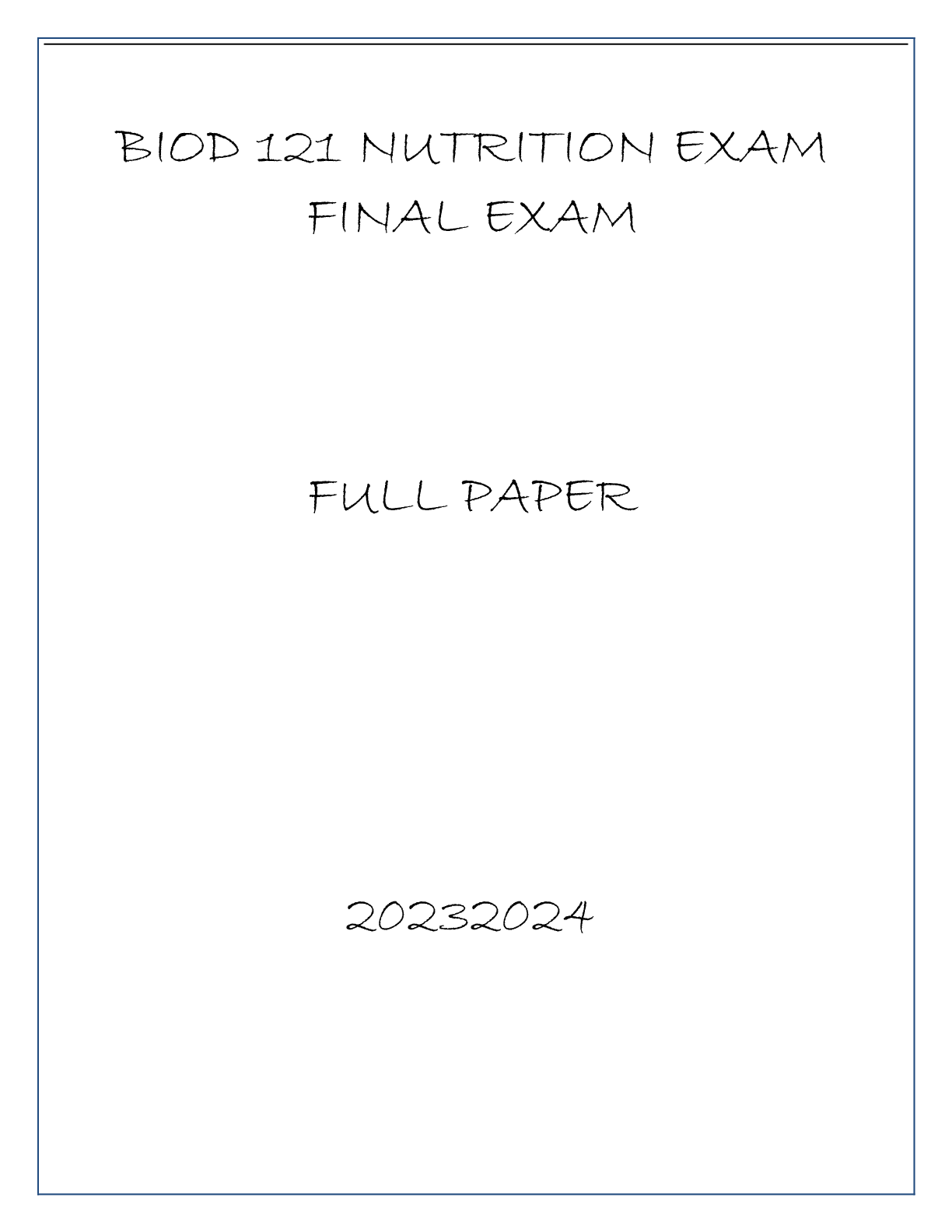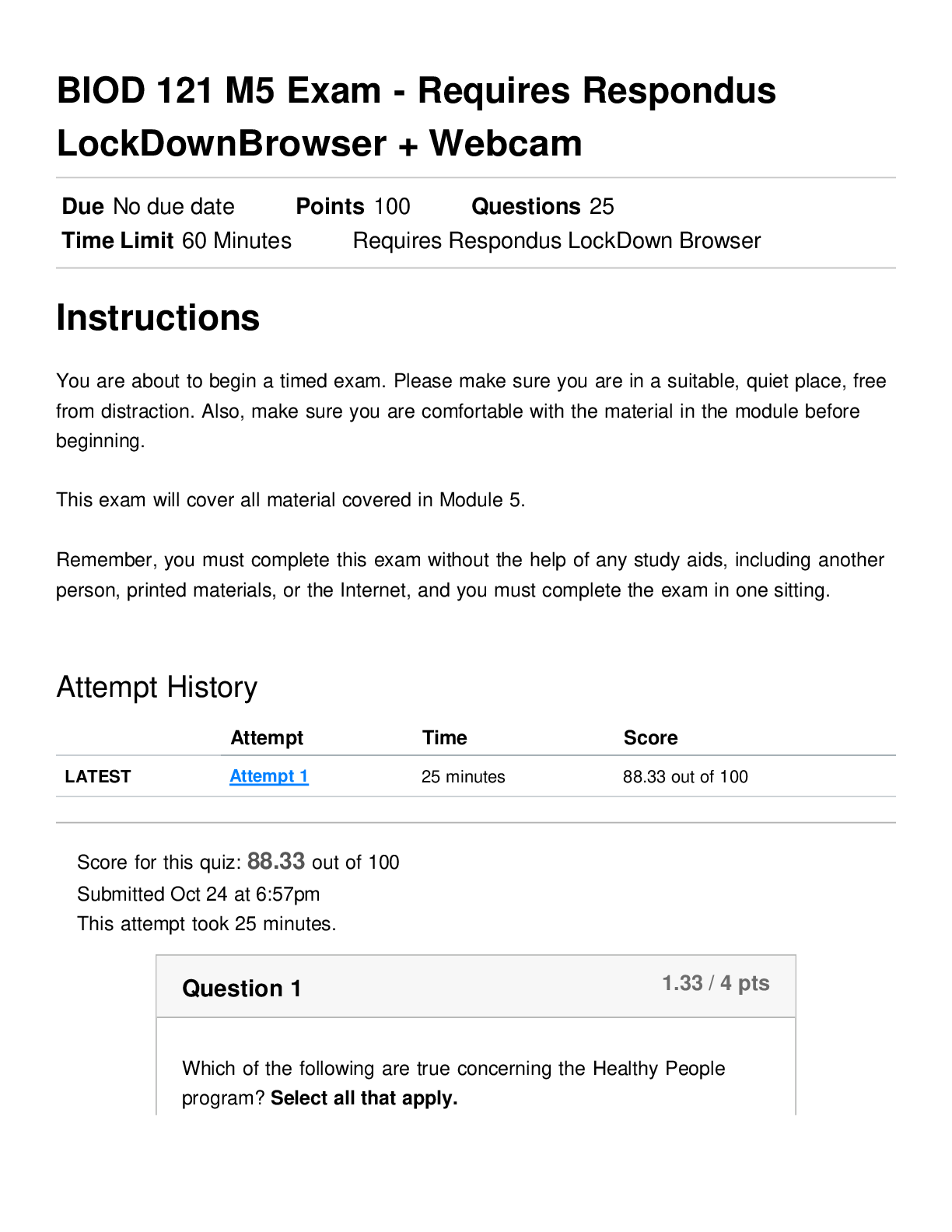Portage Learning BIOD 121 Nutrition EXAM COMP,100% CORRECT
Document Content and Description Below
Portage Learning BIOD 121Nutrition EXAM COMP ● What is the difference between hunger and appetite? Hunger is the internal drive to find and eat food.Appetite is the external drive that encour... ages us to find and eat food . Hunger is related to the negative sensations caused by the lack of food, while Appetite is related to the pleasurable sensations involved with eating food we enjoy. ● List two examples of Environmental external forces that can influence eating habits and comment on your personal experience with each of them.An example of an environmental external force is economics. This affects my personal life by the relationship of income and food, that with certain or limited incomes that only some foods can be purchased. Another example is lifestyle, this affects personal life because it is surrounded by conditions such as time, convenience, or income. ● Hunger is the INTERNAL drive to find and eat food. It is often experienced as a negative sensation. ○ Appetite is theEXTERNAL drive that encourages us to find and eat food. Related to pleasant sensations associated with food. ● Minerals are considered both Micronutrients and Inorganic ● Define organic Organic - a compound that contains carbon and hydrogen ● If a fudge brownie has 15 grams of carbohydrates, 2 grams of protein and 13 grams of fat. How many calories are in the brownie?15 x 4 =60 2 x 4 = 8 13 x 9 = 117 60 +8 + 117= 185 calories ● The current recommendation to maintain your body weight is 2000 calories daily.You should not consume any more than 45 % of your calories from carbohydrates.How many grams of carbohydrates should you eat in a day?225 grams(2000 x .45 =900 900calories/ 4 = 225 grams of carbs) ● 1. The state of DESIRABLE nutrition can be achieved by eating a variety of foods which provide all the essential nutrients. ○ Malnutrition can either be a nutritional state of OVER or UNDER nutrition. ● An individual’s health can be assessed using the ABCDEs of nutritional assessment. Give a brief description of what C stands for. Clinical assessment physical exam and general appearance ● According to MyPlate, what types of food should we increase in our diet? Fruits, vegetables, whole grains, low fat dairy ● 250 calories per serving x 2 servings per container= 500 calories ● Specific parts of the GI tract include the mouth, esophagus, STOMACH , small intestine, LARGE INTESTINE and RECTUM. Other organs such as the liver, gallbladder and pancreas aid in digestion but are not considered part of the GI tract. ● Explain the symptoms of Irritable Bowel Syndrome.Irritable bowel syndrome is not well understood but causes bloating and abdominal pain. ● Name two sphincters discussed in the module and using your own words, briefly describe their functions.The esophageal sphincter prevents the contents of the stomach from reentering the esophagus. The pyloric sphincter controls the release of chyme into the small intestines from the stomach. The ileocecal sphincter prevents the contents of the large intestine from entering the small intestine. ● Define peristalsis. Is this an example of chemical or mechanical digestion? Peristalsis is muscular contractions that move the food mixture along the GI tract while it mixes with a variety of enzymes and other chemicals. It is an example of mechanical digestion. ● ● Which of the following is NOT True concerning blood sugar regulation?Insulin is secreted by the gallbladder ● Name the food groups that lacto vegetarians will include in their diet and those that they avoid. Lacto vegetarians will consume dairy products but no eggs or animal flesh. ● The biological value of a protein is different in animal vs plant sources. Animal sources are considered high quality or COMPLETE proteins. Plant sources are considered lower quality or INCOMPLETE protein. When two or more plant proteins combine, the proteins are called COMPLEMENTARY proteins. A condition resulting from regularly consuming insufficient amounts of proteins and calories is called protein- calorie malnutrition. ● Which of the following is Not True concerning fats and lipids?Trans fats are naturally occurring fats that raise cholesterol levels ● Define protein calorie malnutrition.Protein calorie malnutrition is inadequate intake of protein and calories over a period of time which leads to muscle wasting, and increased risk of infection due to a compromised immune system. ● Which of the following questions is NOT true of the basal metabolic rate (BMR)? The BMI is higher in women then men ○ TRUE: The BMR decreases with age , The BMR is the largest component of energy expenditure , The BMR typically decreases on a weight loss diet ● Using the guidelines for Body Mass Index someone with a body mass index of < 18.5 would be considered UNDERWEIGHT. ● ● 1. The distribution of fat in the body is important. Males often have an APPLE shape, often referred to as android obesity. ○ 2. Females have a PEAR shape often referred to as gynoid obesity. ○ 3. The shape that has the highest health risks associated with it is the APPLE shape. ● Which person is at a greater risk for health issues related to being overweight or obese?Janet has a BMI of 24 and a waist to hip ratio of .8. Fred has a BMI of 25 and a waist to hip ratio of 1.0. FRED ● Why would a standard BMI table not be appropriate for a pregnant mom who is expecting twins?The standard table is not made for children. There is a separate table for pregnant moms. ● Nature and nurture both play a role in determining our weight. Mark each statement as nature or nurture. One parent is obese so their children have a 40% greater risk of being obese NATURE. ○ High fat diets and inactivity promote weight gain NURTURE. ○ Your ethnic heritage influences your perception of beauty NURTURE. ● Joe has been cutting his portion size and has taken up drawing in the evenings to decrease the amount of snacks he used to consume in front of the TV. There is one more component of a good weight loss program that is missing, what is it? EXERCISE ● Positive energy balance occurs when energy intake is greater than energy expenditure resulting in weight GAIN. ○ A negative energy balance occurs when intake is less than energy expended resulting in a weight LOSS. ○ Most adults should be in a state of energy balance where energy intake is EQUAL to energy output. This results in weight ● ● Fat soluble vitamins have all the following characteristics except: Are vulnerable to cooking losses ○ INCLUDE: They are organic, They are dependent on fat intake, Are absorbed into the lymph system ● Fat soluble vitamins have all the following characteristics except: All are synthesized by the body ○ INCLUDE: They are organic, Are absorbed into the lymph system, Are stored in large quantities ● Lack of this vitamin can lead to rickets in children and osteoporosis in adults. Vitamin D ○ Xeropthalmia is a result of a deficiency of Vitamin A. ● Vitamin C is important in the formation of COLLAGEN a connective tissue. ○ Like Vitamin A and Eit works as an antioxidant scavenging free radicals. Combining iron with good sources of this vitamin will improve its absorption. ○ A deficiency results in SCURVY which can be prevented by consuming citrus fruits. This vitamin is often marketed as a cure for the common cold. ● A friend of yours is a weight lifter. He just purchased a supplement of vitamin B-6. What are the side effects of mega doses of this vitamin?Megadoses of B-6 from supplements can cause hand and foot numbness as well as irreversible nerve damage. ○ Why would he consider taking this?Weight lifters use large amounts to build muscle mass. ● A deficiency of thiamin results in beriberi which translates to I can’t I can’t. ○ Pellagra is a deficiency of niacin and the symptoms include diarrhea, dermatitis, DEMENTIA and death. ○ Ariboflavinosis results from a riboflavin deficiency leading to an inflamed tongue known as glossitis and CHEILOSIS , cracks around the mouth. ○ A deficiency of folate and vitamin B-12 both result in megaloblastic anemia, formation of large immature red blood cells. ● To prevent dehydration two hormones are secreted. Aldosterone is secreted from the ADRENAL GLANDS to conserve sodium and water. ○ The pituitary glands release ANTIDIURETIC HORMONEto decrease urine output. ● Ions that are inside and outside the cells control water balance in the body. Explain what happens when blood volume decreases and what 2 ions are responsible for this.If blood volume decreases the water will shift from inside the cells to the bloodstream to raise the blood volume. Sodium and chloride control extracellular fluid balance. ● Minerals are essential NUTRIENTS. The degree to which they can be absorbed is called their bioavailability. ○ Minerals needed in amounts > 100 mg per day are called MAJOR minerals while those needed in quantities < 100 mg daily are TRACE minerals. ○ Unlike vitamins they are not destroyed by heat, light and exposure to air. ● Name the food sources that are good sources of heme iron.Iron found in animal flesh is in the form of hemoglobin or myoglobin (found in muscle cells) is referred to as heme iron and is easily absorbed. ● ● Determine the maximum heart rate and the target zone for a 30 year old. ○ 1. Maximum heart rate 190 ○ 2. Target zone (190x 0.6=) 114to (190x 0.9=) 171beats/minute ● The primary fuel used for an hour weight lifting session would be FAT ● Name the first source of energy for the cells when performing any activity. How is it formed? Adenosine triphosphate (ATP) is the first source of energy for cells. Following digestion, energy is released from food and bonds with adenosine diphosphate (ADP) and a phosphate group to form ATP. ● Dehydration can lead to serious consequences including heat exhaustion, HEAT CRAMPS and heatstroke. ○ For every pound lost during a workout 2 ½ to 3 cups of fluid should be consumed during the exercise or afterwards. ○ Sports beverages are good for events lasting greater than 60 minutes and provide carbohydrates, SODIUM and potassium which will stimulate THIRST and make the beverage taste good. ● Which of the following is not characteristic of disordered eating? Intuitive Eating ● Which eating disorder best describes this scenario? Although his parents encourage Tony to eat breakfast, he rarely feels hungry. Besides he can sleep in an extra 15 minutes if he skips breakfast. After school he has soccer practice then comes home for dinner. In the evening he studies and snacks. He usually goes to bed around 11:30 but rarely sleeps through the night. Once he wakes he checks out the left overs from dinner and makes a snack before heading back to bed. Night eating syndrome ● Which of the following is not a characteristic of Anorexia Nervosa? Food equals comfort ○ CHARACTERISTICS: Control of food leads to empowerment, preoccupied with food, denial of appetite ● Which of the following is not a characteristic of Bulimia Nervosa? Restriction equals empowerment ○ CHARACTERISTICS: Food equals comfort, lack of control, binging and guilt ● Undernutrition is the most common form of MALNUTRITION in developed as well as developing countries. ○ Food insecurity is the inability to get enough food or the quality and variety of the food is inadequate to meet NUTRIENT needs. ● Name three subpopulations in the U.S .that are susceptible to malnutrition.The Working poor, Isolated individuals such as alcoholics, mentally ill or drug addicts who lack access to food resources, the homeless, the elderly and children. ● The first stage of gestation, during which rapid cell division occurs is known as the blastogenic stage. DEVELOPMENT occurs from about week two through the eighth week and is called the embryonic stage. ○ The FETAL stage occurs from week nine to the end of the pregnancy and is a period of growth. ○ All pregnancies are divided into three equal time periods, known as TRIMESTERS, each lasting approximately 13-14 weeks. A baby born after the thirty seventh week of pregnancy is considered full term. ● Name three strategies used to manage the symptoms of morning sickness during pregnancy.Morning sickness- Avoiding greasy foods, eating smaller meals, having good ventilation when cooking and avoiding large amounts of liquid at one time may all help alleviate the symptoms of morning sickness. ● Prior to delivery, hormones prepare the breast for milk production. ○ Prolactin is a hormone secreted by the PITUITARY GLAND for milk production. ○ As the baby suckles OXYTOCIN stimulates the lobules and the letdown reflex to secrete milk. ○ During the first few days following birth COLOSTRUM , which is high in protein and immune factors, is secreted. This helps protect the intestinal health of the infant. ● Human milk or formula should meet the total nutrient needs for the first six months of life. ○ Both are rich in fat to provide a concentrated source of calories and for BRAIN and nervous system development. ○ Arachidonic and DOCOSAHEXAENOIC acid are long chain fatty acids essential for brain and eye development. ○ Solid foods can be introduced at 6 months of age. A new food should be introduced at the rate of one per WEEK to check for allergies. ● Name three common feeding problems that occur among preschoolers.Preschoolers are often picky eaters who need to snack frequently. Avoidance of vegetables and food jags are common. ● During growth spurts adolescents have increased need for CALCIUM for bone formation and IRON to prevent anemia. ○ A typical diet is also low in zinc, fat soluble vitamins and folate. ○ Teenagers should moderate their intake of fast food, sugar laden snacks and sugary beverages and focus on NUTRIENT DENSE food choices from the five food groups. ○ The media, peer pressure, concern over appearance and exertion of independence all affect their food choices. ● How much physical activity is recommended for children each day? 60 minutes ● The increased incidence of overweight/obese children and teens and poor diet habits has resulted in all the following for this age group except: Type 1 diabetes ○ INCLUDES: Hypertension, Type 2 Diabetes, Cardiovascular Disease ● There are two main factors that are related to nutrient needs of adults and nutrition concerns that occur with aging. These factors are? Physiological changes and psychosocial needs ● The rate at which we age is influenced by several factors including lifestyle, environment and HEREDITY. ○ Physical and physiological changes that are an expected part of aging such as increased fatty tissue, high blood pressure and declining bone and lean body mass is referred to as USUAL aging. ○ Individuals who make wise diet and lifestyle choices can decrease the risk for disease and age-related decline of functions occur at a slower rate. This is called SUCCESSFUL aging. ● Explain why quality is more important than quantity in an older adults diet.As we age calorie needs decrease but nutrient needs remain the same or even increase. To prevent weight gain calories need to be decreased but adequate nutrients still need to be consumed. [Show More]
Last updated: 1 year ago
Preview 1 out of 9 pages
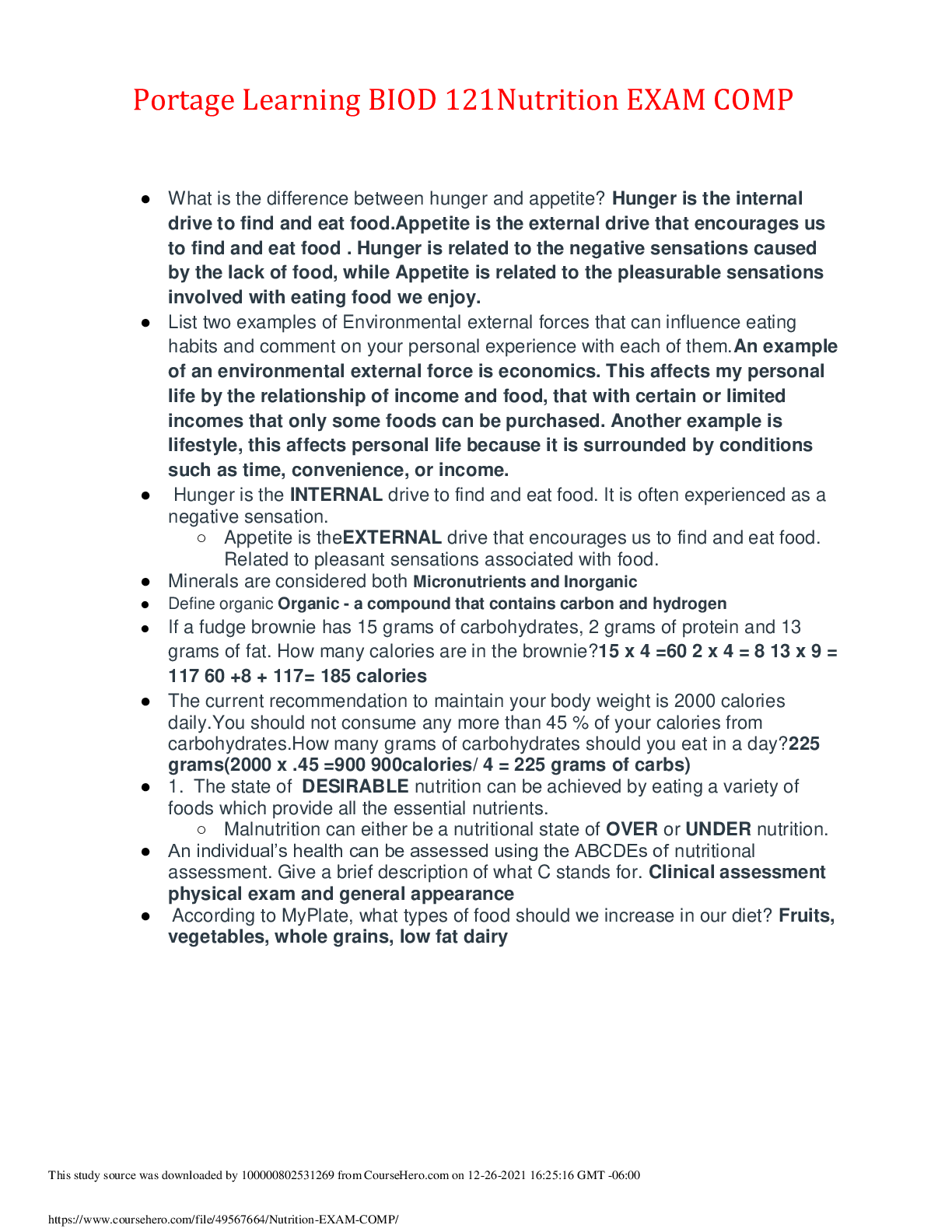
Reviews( 0 )
Document information
Connected school, study & course
About the document
Uploaded On
Jan 05, 2022
Number of pages
9
Written in
Additional information
This document has been written for:
Uploaded
Jan 05, 2022
Downloads
0
Views
54






